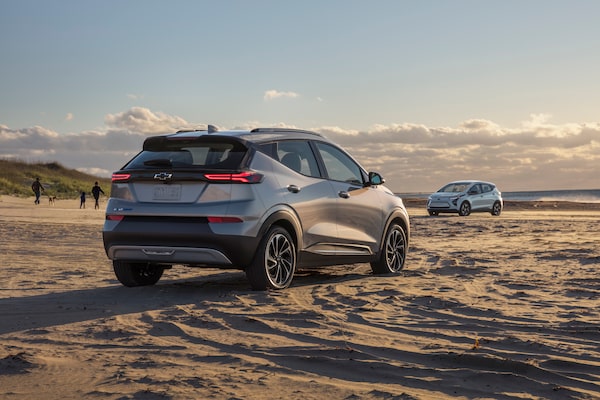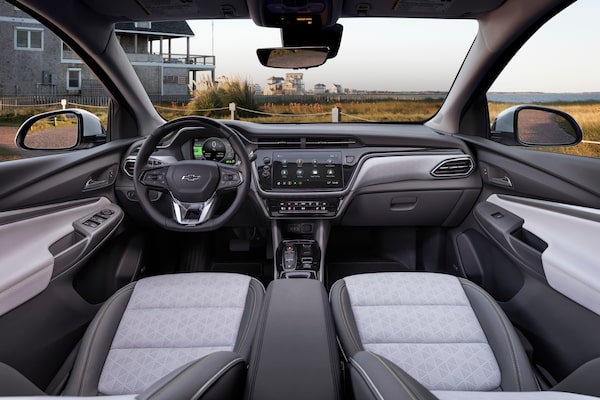
2022 Chevrolet Bolt EUV (front) and EV.Courtesy of manufacturer
On the face of it, the most noteworthy aspect of the Chevrolet Bolt EV’s 2022 do-over is the price. Very little has changed mechanically on this electric vehicle; there’s a minor exterior freshening, and the dashboard has been refashioned. Over all, not much more than a nip ‘n’ tuck, really.
What really makes the 2022 more desirable than its predecessor, however, is the reduction of almost $7,000 from the manufacturer’s suggested retail price: Last year, it was $44,998; this year, $38,198.
But for those who still won’t buy a Bolt EV because it looks too much like – shock, horror – an econobox hatchback, Chevrolet has added the EUV. It’s “the best of the Bolt EV packaged in an SUV-like vehicle with more technology and features,” explains Cadillac vice-president Steve Hill.
The EUV (electric utility vehicle) will be the first Chevrolet to offer optional Super Cruise, a hands-free driver assistance system for roads that have been pre-mapped by the auto maker.
As well, for $2,000 more than the EV, the EUV includes as standard a dual-level charge cord (optional on the EV) compatible with both Level 1 charging on a standard 120-volt outlet and Level 2 charging (up to 7.2 kilowatts) on a household oven/dryer 240-volt outlet. However, you will need a stand-alone wall-box Level 2 charger to use the full 11 kilowatts of Level 2 charging that both Bolts can now handle.
The EUV is 16 centimetres longer than the EV on a 7.5-centimetre-longer wheelbase, but neither width nor height nor ground clearance are materially different. It’s not all-wheel drive either, so it’s not really an SUV. What you do get is more rear legroom, more seats-folded cargo length and the opportunity to be sold a Premier trim plus Super Cruise and other luxuries not offered on the EV.

Even the smaller Bolt EV packages compact-class interior space into its subcompact-sized exterior, and the EUV expands on that.Courtesy of manufacturer
But the EUV weighs at least 40 kilograms more, which translates into slightly higher energy consumption, and hence the range is reduced to 397 kilometres from the EV’s 417.
We spent a week with the Bolt EV in July, but before we could get into an EUV, Chevrolet’s battery-fire recall was extended to all model years and, “out of an abundance of caution,” GM Canada grounded its test vehicles for review by automotive journalists.
It’s safe to assume, however, that the EUV will drive very much like its stubbier sibling, except marginally slower and less agile, and possibly a bit smoother-riding. Note, too, the wall-to-wall turning circle is almost a full metre wider.
In the warmer months, both versions of the Bolt should have no trouble achieving their claimed ranges. Our first five days and 240 kilometres of mixed driving with the EV left us with 189 kilometres of range remaining on the gauge. We only did a full recharge at that point because we were planning an expedition the next day to Presqu’ile Provincial Park near Belleville, Ont., a mostly-freeway, 180-kilometre drive from our Mississauga home.
Throw in some pottering around within the park and that day trip ended with 382 kilometres driven, and 44 kilometres of range remaining. That’s with three occupants, mostly cruising at 110 to 115 kilometres an hour, with the air conditioning on. Electric-vehicle range tends to be favoured by city driving, not highway.
If you’re already committed to buying an electric vehicle, the Bolt EV at its new price is a compelling proposition (or will be, once the battery recall is done). But we don’t see an equally compelling case for the EUV, unless you actually buy into its pretend-SUV shape, or really need the extra rear-seat leg room. That said, the EUV – in its pricier Premier trim at that – is unavoidable if you want Super Cruise, a sunroof or navigation. Check all those boxes and you’re looking at closer to $50,000 than the $38,198 that first lured us into the showroom.
Looks
While the EV gets a new face for 2022, the new EUV has all its own sheet-metal designed to look more SUV-like. About half of its extra 16 cm of length is in the wheelbase, most of the rest going into a more pronounced snout. No significant change in height, though.
Interior
Even the smaller Bolt EV packages compact-class interior space into its subcompact-sized exterior, and the EUV expands on that with an added 8 cm of rear legroom. Up front there’s still a digital gauge cluster and a 10.2-inch display, but they’re packaged into a new, more upscale dashboard, with dark shades and traditional shapes replacing the previous light greys and abstract-art sculpting. An 8-way power driver’s seat is now standard and should enable a greater variety of preferred postures than the previous 6-way manual chair. There’s also a more conventional full-length centre console separating the front seats, albeit now with pull-push switches replacing the previous PRNDS lever selector, and new HVAC controls that are less user-friendly than before.

The EUV has 59 L more cargo volume than the EV's 470 L.Courtesy of manufacturer
Performance
It’s no Tesla, but by econocar standards the Bolt is quite peppy. Chevrolet claims 0-96 km/h in less than 7 seconds, a performance all the more pleasing when delivered in near-total silence. Light and lively steering further contributes to an engaging driving experience.
Technology
We didn’t get a chance to try it, but clearly the option of Super Cruise is the technology headline – though only on the EUV Premier. All Bolts include automatic amergency braking, forward collision alert, lane keep assist, and lane departure warning, while adaptive cruise control is standard on the EUV Premier but not available on LT trims.
Cargo
The Bolt EV has competitive subcompact cargo volume with 470 L behind the rear seats when the detachable cargo-deck floor is removed. Or leave the floor in place for a floor that’s flush with the folded seatbacks, with hidden storage below. Curiously, the specs say the EUV has marginally less volume behind the seats but apparently that’s due to a quirk in the SAE methodology for measuring it. By ISO standards, we’re told, the EUV has 59 L more cargo volume. Most of that, it seems, must be at ceiling height because our tape measure showed no meaningful difference in the area of their trunk floors. The EUV does, however, have about 8 cm more length for cargo with the rear seats folded.
Tech specs
2022 Chevrolet Bolt EV and EUV
Base price: $38,198 (EV); $40,198 (EUV)
Motor/battery: 150-kilowatt-hour electric motor/65-kilowatt-hour battery pack
Transmission/drive: Single-speed automatic/Front-wheel drive
Fuel economy (litre equivalent/100 kilometres): 1.9 city/2.2 highway for the EV (estimated, based on the 2021 model); figure not available for the EUV
Alternatives: Hyundai Kona Electric, Hyundai Ioniq Electric, Kia Niro EV, Kia Soul EV, Mini Cooper SE, Nissan Leaf

It’s no Tesla, but by econocar standards the Bolt is quite peppy.Courtesy of manufacturer
Shopping for a new car? Check out the new Globe Drive Build and Price Tool to see the latest discounts, rebates and rates on new cars, trucks and SUVs. Click here to get your price.